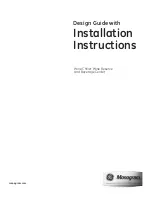
30
TROUBLESHOOTING GUIDE
You can solve many common wine cellar problems easily, saving you the cost of a possible service
call. Try the suggestions below to see if you can solve the problem before calling the service.
PROBLEM
POSSIBLE CAUSE
SOLUTION
Cellar does not
operate.
Not plugged in.
The appliance is turned off.
The circuit breaker tripped or a blown fuse.
Plug the unit.
Turn on the unit.
Check the breaker and/or fuses.
Cellar is not cold
enough.
External environment may require a higher
setting.
The door is opened too often.
The door is not closed completely.
The door gasket does not seal properly.
Check the temperature control setting.
Close the door properly.
Check the door gasket.
The compressor
turns on and off
frequently.
The room temperature is hotter than normal.
A large amount of contents has been added
to the cellar.
The door is opened too often.
The door is not closed completely.
The temperature control is not set correctly.
The door gasket does not seal properly.
Close the door properly.
Check the door gasket.
The fans turn on
and off
frequently.
In order to circulate the air and maintain the set temperature inside the cabinet the fans
must cycle on and off even when the compressor is off. The fans will cycle ON and OFF
while the compressor is off approximately every 20 seconds, this is call
ed “Semi-speed
status”. This cycle is normal and meant both to circulate the air as well as ensure the
continued operational status of the fans. If the fan stops completely and does not
complete this cycle the fan is non-operational.
Fan is always
running
This is simply a function of the cooling system. The lower the setting, the more the fan
will run. If the room is very warm, the cooler will run more. The unit has been designed to
run continuously when operating at the lower temperatures.
The light does
not work.
Not plugged in.
The circuit breaker tripped or a blown fuse.
The light button is “OFF”.
Plug the unit.
Check the breaker and/or fuses.
Vibrations.
The cellar is not levelled
The bottles are vibrating.
There is an object under the cellar.
Check to assure that the Cellar is level.
Make sure the bottles don’t touch each
other.
Remove the object.
The cellar seems
to make too
much noise.
The unit is not level.
Level the cellar.
The rattling noise may come from the
flow of the refrigerant, which is normal.
As each cycle ends, you may hear
gurgling sounds caused by the flow of
refrigerant in your cellar. Contraction and
expansion of the inside walls may cause
popping and crackling noises.
Display shows
an error code
The air temperature sensor in the
corresponding temperature zone has failed
Call CAVAVIN
Содержание C-155WDZ-V4
Страница 17: ...17 ...
Страница 35: ...35 C 155WDZ V4 20190801 Printed in China Imprimé en Chine ...






























